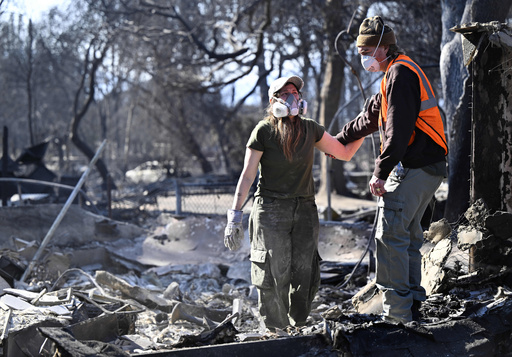
SACRAMENTO, Calif. — Following the devastating wildfires that swept through Los Angeles in January, Governor Gavin Newsom announced plans to implement previously stalled regulations requiring homeowners in high-risk areas to remove flammable debris from around their properties.
While details regarding the timeline for this executive order have not been made clear, it comes in the wake of a law passed by the state legislature in 2020, which was initially intended to take effect by January 1, 2023. The governor is expected to formalize this order after returning from Washington, where he is seeking disaster relief funding.
The regulation mandates that homeowners in fire-prone zones clear away combustible items like dead vegetation and wooden furniture within a five-foot radius of their homes. During the series of fires that affected several neighborhoods in Los Angeles, the implementing regulations were still in the drafting phase. The state Board of Forestry and Fire Protection acknowledged last month that it lacked a clear schedule for finalizing these rules.
At a recent November meeting, officials indicated that the draft language for these regulations is unlikely to be reviewed until late 2023. Despite the delays, the state has been promoting the importance of maintaining clear surroundings on its website.
Some legislators who championed the original bill expressed their dissatisfaction with the prolonged process, emphasizing that timely regulation could have reduced fire damage during events like the Palisades Fire, which is now recognized as the most devastating wildfire in Los Angeles history. Most homes affected by this disaster fall within areas designated as high-risk by the California Department of Forestry and Fire Protection and are thereby subject to these new safety requirements.
The Palisades Fire, fueled by extreme winds that dispersed embers, resulted in the destruction of over 5,000 structures across regions such as Pacific Palisades, Malibu, and Topanga Canyon. According to the current proposal, existing homes will have a three-year compliance period with the new regulations, raising questions about how many structures might have been protected had they already been in effect. Experts generally agree that timely clearing of flammable materials could have made a difference.
California’s Natural Resources Secretary Wade Crowfoot noted that these new measures are designed to prompt preemptive actions to safeguard vulnerable homes from ember-driven blazes by advocating for the elimination of combustible materials near residences. This initiative will also instruct CalFire to expand the fire-prone area map significantly, adding approximately 1.4 million acres designated for fire mitigation efforts. Homeowners in these regions will then have to adhere to the corresponding regulations.
Some municipalities and residents have already begun taking measures to clear combustibles voluntarily. Governor Newsom stated that this initiative is part of a larger strategy to adapt to increasingly severe weather events, which current infrastructure was not designed to withstand. The measures will complement existing efforts in forest management, equipment enhancement, and state-of-the-art firefighting techniques.
In addition to regulatory changes, the governor has proposed a funding allocation of $25 million to ensure compliance with the new regulations and support other fire safety measures. However, it’s noteworthy that many neighborhoods affected by the recent Eaton fire, including portions of Pasadena and Altadena, are not classified as fire-prone under state designations and therefore will not be subject to these new rules.
Roy Wright, the CEO of the Insurance Institute, expressed optimism regarding the announcement, citing a new sense of urgency from the governor’s office after years of stagnation. He emphasized that this commitment signifies a priority for California’s residents to enhance safety measures.
California currently enforces robust defensible-space regulations requiring homeowners in high-risk areas to keep flammable landscaping clear within a 30-foot perimeter established decades ago, expanding to a 100-foot safe zone in 2006. The new proposal establishes a so-called “zone zero,” mandating the removal of objects like wooden fencing and mulch within five feet of homes to mitigate fire risks caused by wind-driven embers. Research indicates that embers are responsible for about 90% of wildfire-related property damage.
The bipartisan support for this “zone zero” regulation emanated from the urgent need for action following catastrophic fire seasons in 2017 and 2018, which included a disaster that nearly obliterated the town of Paradise, resulting in over 17,000 structures lost and the tragic death of 85 individuals.

